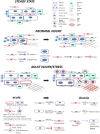Three in a Box: Understanding Cardiomyocyte, Fibroblast, and Innate Immune Cell Interactions to Orchestrate Cardiac Repair Processes
- PMID: 31001541
- PMCID: PMC6454035
- DOI: 10.3389/fcvm.2019.00032
Three in a Box: Understanding Cardiomyocyte, Fibroblast, and Innate Immune Cell Interactions to Orchestrate Cardiac Repair Processes
Abstract
Following an insult by both intrinsic and extrinsic pathways, complex cellular, and molecular interactions determine a successful recovery or inadequate repair of damaged tissue. The efficiency of this process is particularly important in the heart, an organ characterized by very limited regenerative and repair capacity in higher adult vertebrates. Cardiac insult is characteristically associated with fibrosis and heart failure, as a result of cardiomyocyte death, myocardial degeneration, and adverse remodeling. Recent evidence implies that resident non-cardiomyocytes, fibroblasts but also macrophages -pillars of the innate immunity- form part of the inflammatory response and decisively affect the repair process following a cardiac insult. Multiple studies in model organisms (mouse, zebrafish) of various developmental stages (adult and neonatal) combined with genetically engineered cell plasticity and differentiation intervention protocols -mainly targeting cardiac fibroblasts or progenitor cells-reveal particular roles of resident and recruited innate immune cells and their secretome in the coordination of cardiac repair. The interplay of innate immune cells with cardiac fibroblasts and cardiomyocytes is emerging as a crucial platform to help our understanding and, importantly, to allow the development of effective interventions sufficient to minimize cardiac damage and dysfunction after injury.
Keywords: cardiac fibroblasts; cardiac macrophages; cardiac regeneration; cardiac repair; cardiomyocytes; fibrosis; heart failure; innate immune cells.
Figures

Similar articles
-
Cardiomyocyte proliferation: Advances and insights in macrophage-targeted therapy for myocardial injury.Genes Dis. 2024 May 19;12(3):101332. doi: 10.1016/j.gendis.2024.101332. eCollection 2025 May. Genes Dis. 2024. PMID: 39935606 Free PMC article. Review.
-
The Macrophage-Fibroblast Dipole in the Context of Cardiac Repair and Fibrosis.Biomolecules. 2024 Nov 4;14(11):1403. doi: 10.3390/biom14111403. Biomolecules. 2024. PMID: 39595580 Free PMC article. Review.
-
Harnessing the innate and adaptive immune system for tissue repair and regeneration: Considering more than macrophages.Acta Biomater. 2021 Oct 1;133:208-221. doi: 10.1016/j.actbio.2021.02.023. Epub 2021 Feb 28. Acta Biomater. 2021. PMID: 33657453 Review.
-
Inflammation in cardiac injury, repair and regeneration.Curr Opin Cardiol. 2015 May;30(3):240-5. doi: 10.1097/HCO.0000000000000158. Curr Opin Cardiol. 2015. PMID: 25807226 Free PMC article. Review.
-
Micromanaging cardiac regeneration: Targeted delivery of microRNAs for cardiac repair and regeneration.World J Cardiol. 2016 Feb 26;8(2):163-79. doi: 10.4330/wjc.v8.i2.163. World J Cardiol. 2016. PMID: 26981212 Free PMC article. Review.
Cited by
-
Skeletal and Cardiac Muscle Disorders Caused by Mutations in Genes Encoding Intermediate Filament Proteins.Int J Mol Sci. 2021 Apr 20;22(8):4256. doi: 10.3390/ijms22084256. Int J Mol Sci. 2021. PMID: 33923914 Free PMC article. Review.
-
Role of miRNA-1 and miRNA-21 in Acute Myocardial Ischemia-Reperfusion Injury and Their Potential as Therapeutic Strategy.Int J Mol Sci. 2022 Jan 28;23(3):1512. doi: 10.3390/ijms23031512. Int J Mol Sci. 2022. PMID: 35163436 Free PMC article. Review.
-
Early Protective Role of Inflammation in Cardiac Remodeling and Heart Failure: Focus on TNFα and Resident Macrophages.Cells. 2022 Apr 6;11(7):1249. doi: 10.3390/cells11071249. Cells. 2022. PMID: 35406812 Free PMC article. Review.
-
Hydrogen Sulfide as a Potential Alternative for the Treatment of Myocardial Fibrosis.Oxid Med Cell Longev. 2020 Jan 23;2020:4105382. doi: 10.1155/2020/4105382. eCollection 2020. Oxid Med Cell Longev. 2020. PMID: 32064023 Free PMC article. Review.
-
Osteopontin: A Promising Therapeutic Target in Cardiac Fibrosis.Cells. 2019 Dec 3;8(12):1558. doi: 10.3390/cells8121558. Cells. 2019. PMID: 31816901 Free PMC article. Review.
References
Publication types
LinkOut - more resources
Full Text Sources

